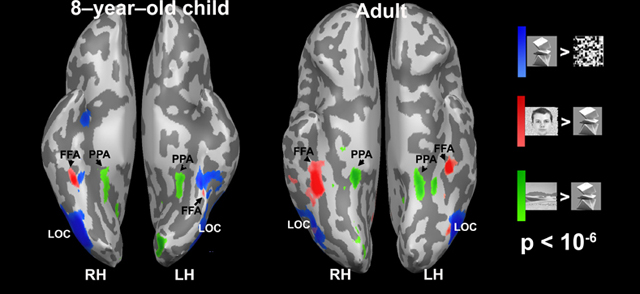Golijeh Golarai
Senior Research Associate
Development of Functional Specialization in the Human Ventral Stream.

Face, place and object -selective regions in children, adolescents and adults.
Face, place and object-selective activations are shown for one representative child (eight years old)
and one representative adult
(adapted from Golarai, et al., Nature Neuroscience 2007).
Activation maps were generated by a voxel-by-voxel general linear model (GLM) (no spatial smoothing) in each subject and
are shown on an inflated cortical surface of each of the individual subjects in the ventral view.
Red: faces > abstract objects; green: scenes > abstract objects;
blue: abstract objects > textures created by scrambling intact object images.
The threshold for all contrasts was at the same significance level(P < .000001, voxel level, uncorrected).
Abbreviations: FFA, fusiform face area; PPA, parahippocampal place area; LOC, lateral occipital complex.
Only the ventral aspect of the LOC is visible in this view.
Experience Shapes the Development of Neural Substrates of Face Processing in Human Ventral Temporal Cortex.
In a recent study we examined what role visual experience plays in the development of the topology
of category selective regions in human ventral temporal cortex (VTC)
Using functional magnetic resonance imaging in children and adults, we found a sequential development,
in which the topology of face-selective activations across the VTC was matured by age 7, but
the spatial extent and degree of face selectivity continued to develop past age 7 into adulthood.
Importantly, own- and other-age faces were differentially represented, both in the distributed
multivoxel patterns across the VTC, and also in the magnitude of responses of face-selective regions.
These results provide strong evidence that experience shapes cortical representations of faces during
development from childhood to adulthood. Our findings have important
implications for the role of experience and age in shaping the neural substrates of face processing
in the human VTC.
To read more about development of the human brain, see:
Trends in Cognitive Sciences, 2008,
Frontiers in Human Neuroscience, 2010
as well as the role of experience during development:
Cerebral Cortex, 2015.
|